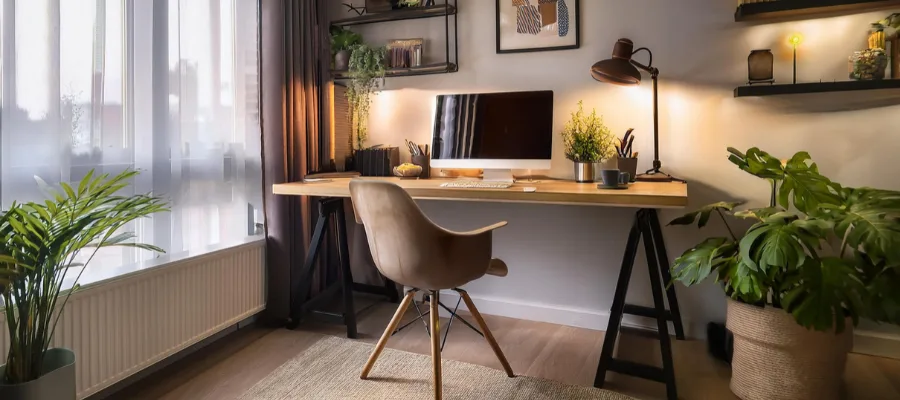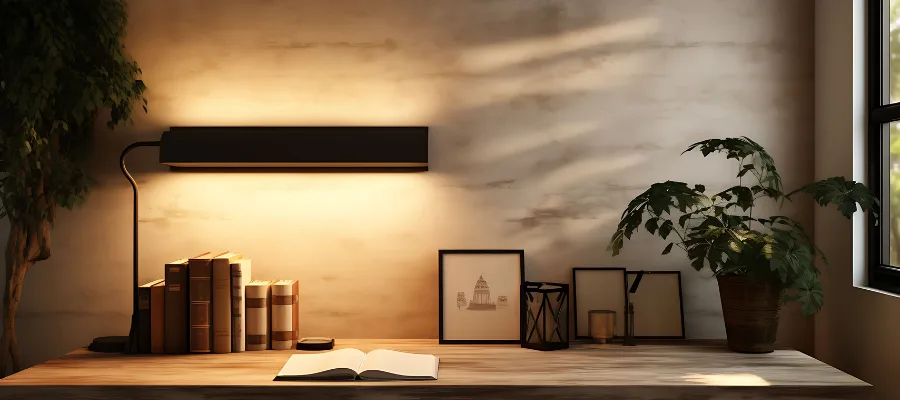Home office design is a procedure of creating a functional, comfortable, and inspiring workspace within your home, including necessary features such as storage, cosy settings, and technology, in a suitable position in your house to enhance productivity and well-being.
Consideration for Planning Your Home Office Setup
Before designing the home office, you need to consider the following factors:
Location of Home Office
To create a functional home office design, you need to pick a suitable location. Choose between energetic, busy areas or privacy for work based on your requirements. Make sure a room has enough space to move around and work productively with natural light allowance. If your house area is limited, you can remake the corners of a larger room or unused closet into a small home office.
Space Requirements
First, understand your space requirements; get a brief idea of how much space is required for efficient working. For comfortability, make the size of the home office between 30 square feet with a small desk setup to over 150 square feet for a wide setup. If you consider general guidelines, a minimum of 70 square feet is necessary to comfortably place a desk and chair with storage solutions.
Natural Light Considerations
Light is essential to maintain better mood and energy levels. You can place your home office near windows or design skylights to receive sufficient light. To increase the brightness, use white or lighter shades to paint the wall. Always choose sheer curtains or light-filtering shades.
Noise Levels and Privacy Requirements
External noise can disturb the home office environment. Make sure the space is not too loud or quiet by maintaining an acceptable noise level of around 50 decibels. To enhance privacy, you can use noise-reducing materials like carpets and wall panels. If you don’t have other options than in an open area, use room dividers to create visual and auditory barriers to reduce distractions from household activities or conversations.
Traffic Flow and Accessibility
The home office design should always maintain the flow of traffic. There should not be any obstacles that disturb the way. Even people with disabilities should also be able to move there. Space for the path should be maintained around desks; walkways of atleast 36 inches are advised for comfortable movements. Storage areas should be well-placed to be clear and maintain an organised and clutter-free space.
Home Office Setup with Furniture and Layout
You can make your home office interior design by including essential furniture and layout elements in ergonomic means as follows:

Choose Ergonomic Furniture
Instead of choosing any random furniture, choose ergonomic furniture. Ergonomics is the concept of designing and arranging the workspace to enhance work efficiency with comfort and considering worker health. Ergonomic chairs or other furniture are designed to give comfort and reduce back pain, eye strain, and musculoskeletal disorders (pain that negatively impacts the muscles, bones, joints, tendons, ligaments, and nerves.). Make sure the chair has an adjustable seat height and lumbar support to reduce low back pain and adjust it to fit your body’s dimensions.
Storage Solutions
You need to keep the home office organised and free from clutter, as clutter can cause disturbance and mood swings. Home office layouts commonly include filing cabinets, bookshelves, and organisers to make the essential items easily available. For small office interior design, you can make use of vertical space by installing wall-mounted shelves to optimise storage. For better organisation and quick availability, clear labelling and categorisation of documents and supplies are used. For flexible storage requirements, use mobile carts.
Meeting Space (If Needed)
A specified meeting space will be essential in certain home office setups, particularly for client interactions or collaborative projects. This meeting space should include comfortable seating options for better conversation. For informal meetings, you can use a small round table with a couple of chairs. The home office can also include a more formal arrangement with sofas or lounge chairs to give a professional atmosphere. Ensure the space receives sufficient lighting, naturally or artificially, to create an inviting meeting ambience.
Lighting Design for Designing Home Office

Natural light is essential to create an effective and comfortable home office setup. Positioning the workspace near windows allows sunlight, reducing glare on screens. To reduce harsh sunlight during the afternoon, you can include sheer curtains. If natural light is not available, you can add artificial light options based on light requirements. Task lighting can be used for specific activities such as reading or writing. Flexible desk lamps can direct light exactly where needed, reducing eye strain. For ambient lighting, you can use ceiling fixtures or floor lamps to enhance overall comfort. Avoid direct overhead lighting to reduce shadows and glare on work surfaces.
Home Office Design with Technology Setup
Electrical devices and the complete setup are very important to maintain the flow of work in a home office. Consider the following suggestions for a better technology setup.
- Place the desk and computer in an appropriate position to work comfortably, and make sure monitors are placed at eye level.
- To maintain tidiness, install cable management solutions properly in the home office setup. To keep things organised, make use of cable ties, under-desk organisers, and cable sleeves.
- Power outlets should be easy to reach. Place the desk close to the outlets so you don’t require long cords, which will avoid the possibility of tangling.
- For the internet, you can choose a robust Wi-Fi router or a wired Ethernet connection.
- If necessary, you can include a video conferencing setup with high-quality cameras and a microphone to improve communication during virtual meetings.
Home Office Interior Design
You need to focus on comfortability, health, and wellness, along with the aesthetic appearance of the home office.
Colour Shades
To design your modern home office design calmly and improve concentration, use cool colour tones like blue and green. To enhance the creativity, you can use warm colours like yellow.
Green Elements
You can use plants and creepers to decorate and improve the air quality. It can offer a calm feel, reduce stress levels, and improve concentration.
Customised Interior Decor
By personalising the interior decoration, you can improve your work motivation. Elements such as work-relevant art, family photos, and inspirational quotes improve the work atmosphere.
Ventilation and Temperature
An adequate temperature and proper ventilation are essential to maintain a comfortable work environment. Optimal room temperatures between 21°C and 23°C are advised to enhance concentration. For air quality, you can use air purifiers.
A strategically designed home office is very important in the present case of society, where every single square foot counts. You can create an effective home office setup with a spacious, thoughtful plan, meeting space, and ergonomic furniture.
You can consult an experienced architect or a construction company for more details and support when designing your home office.

